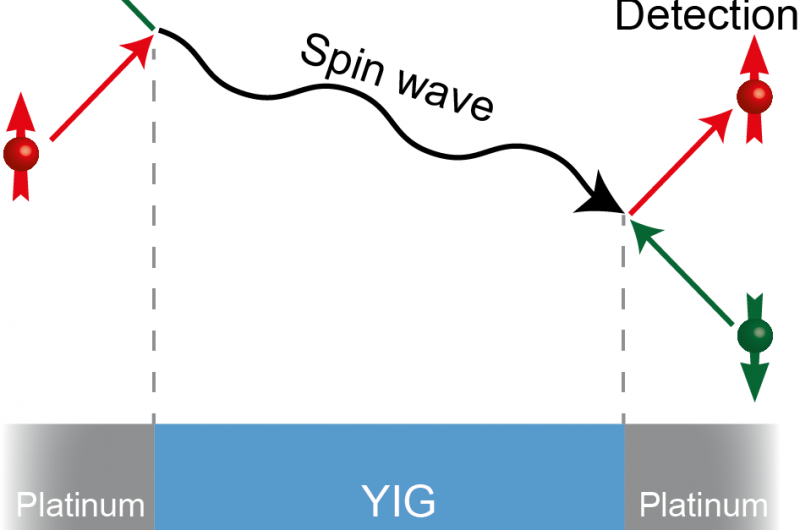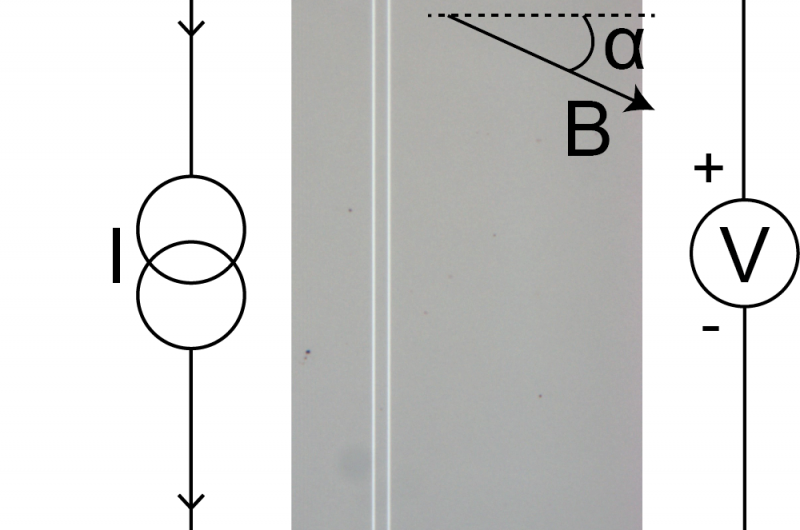First realization of an electric circuit with a magnetic insulator using spin waves

Researchers at the University of Groningen, Utrecht University, the Université de Bretagne Occidentale and the FOM Foundation have found that it is possible to make an electric circuit with a magnetic insulator. This was first deemed impossible. The circuit is realized using spin waves: wave-like perturbations in the magnetic properties of a material. Their discovery is interesting for the development of novel, energy-efficient electronic devices, particularly integrated circuits. A device based on spin waves could theoretically operate more efficiently than ordinary electronic circuits. The results of their research will be published online in Nature Physics on Monday 14 September.
In our current electronic equipment, information is transported via the motion of electrons. In this scheme, the charge of the electron is used to transmit a signal. In a magnetic insulator, a spin wave is used instead. Spin is a magnetic property of an electron. A spin wave is caused by a perturbation of the local magnetisation direction in a magnetic material. Such a perturbation is caused by an electron with an opposite spin, relative to the magnetisation. Spin waves transmit these perturbations in the material. This research demonstrates for the first time that it is possible to transmit electric signals in an insulating material.
Strong perturbation
So far, electrical circuits based on spin waves have not been realised, since it turned out to be impossible to introduce a perturbation in the system large enough to create spin waves. FOM workgroup leader prof.dr. Bart van Wees and his PhD student Ludo Cornelissen, both from the University of Groningen and FOM workgroup leader dr. Rembert Duine from Utrecht University have succeeded to use spin waves in an electric circuit by carefully designing the device geometry. This allows them to make use of the spin waves that are already present in the material due to thermal fluctuations, which requires a much smaller disturbance of the system and hence enables the spin waves to be used in an electric circuit.
The spin wave circuit that the researchers built, consists of a 200 nanometre thin layer of yttrium iron garnet (a mineral and magnetic insulator, YIG in short), with a conducting platinum strip on top of that on both sides. An electron can flow through the platinum, but not in the YIG since it is an insulator. However, if the electron collides on the interface between YIG and platinum, this influences the magnetisation at the YIG surface and the electron spin is transferred. This causes a local magnetisation direction, generating a spin wave in the YIG.

Spin wave detection
The spin waves that the researchers send into the YIG are detected by the platinum strip on the other side of the YIG. The detection process is exactly opposite to the spin wave injection: a spin wave collides at the interface between YIG and platinum, and transfers its spin to an electron in the platinum. This influences the motion of the electron, resulting in an electric current that the researchers can measure.
The researchers already studied the combination of platinum and YIG in previous research. From this research it was found that when spin is transferred from platinum to YIG, this also implies the transfer of heat across the interface. This enables the heating or cooling of the platinum-YIG interface, depending on the relative orientation of the electron spins in the platinum and the magnetisation in the YIG.
More information: L.J. Cornelissen, J. Liu, R.A. Duine, J. Ben Youssef and B.J. van Wees, Long-distance transport of magnon spin information in a magnetic insulator at room temperature, Nature Physics, DOI: 10.1038/nphys3465
Journal information: Nature Physics
Provided by University of Groningen




















